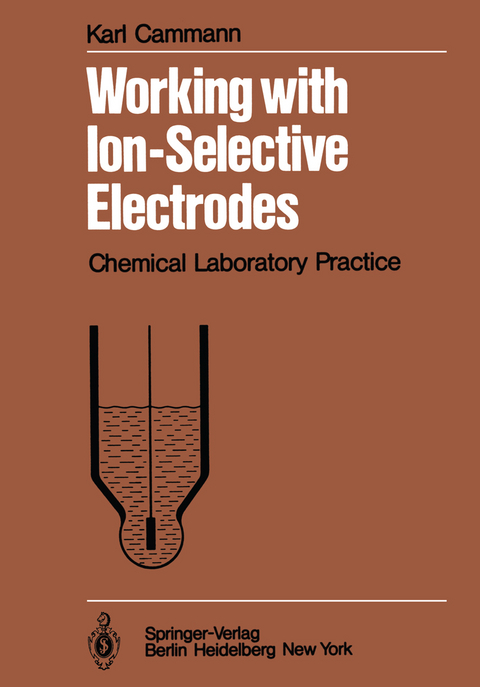
Working with Ion-Selective Electrodes
Springer Berlin (Verlag)
978-3-642-67278-1 (ISBN)
1 Fundamentals of Potentiometry.- 1.1 Electrode Processes.- 1.2 The Nernst Equation.- 1.3 Potential-Determining Ions.- 1.4 Ion-Selective Electrode Materials.- 1.5 The Potentiometric Selectivity Coefficient as a Quantitative Indication of the Electrode Selectivity.- 2 Electrode Potential Measurements.- 2.1 Reference Electrodes.- 2.2 The Standard Hydrogen Electrode as a Primary Reference Electrode.- 2.3 The Liquid Junction Potential.- 2.4 Secondary Reference Electrodes.- 3 Ion-Selective Electrodes.- 3.1 General Construction Principles.- 3.2 Solid-State Membrane Electrodes.- 3.3 Porous and Nonporous Supported Ion Exchanger and Neutral Carrier Membrane Electrodes.- 3.4 Solid State Electrodes with Electroactive Coatings.- 3.5 Gas Sensors For CO2, NH3, SO2, NO2, HF, H2S, HCN, etc..- 3.6 Bio-Sensors.- 4 Measuring Techniques with Ion-Selective Electrodes.- 4.1 Equivalent Circuit for a Cell with Liquid Junction.- 4.2 Measuring the EMF of an Electrochemical Cell.- 4.3 Choosing an EMF Measuring Device.- 4.4 Characteristics of Electrometer Amplifiers.- 5 Analysis Techniques Using Ion-Selective Electrodes.- 5.1 Calibration Curves.- 5.2 Direct Indication on the pH or plon Scale of an Instrument.- 5.3 Titration Procedures for Determining Concentrations.- 5.4 Concentration Determinations with the Help of a Standard Addition with a Known Electrode Slope S.- 5.5 Concentration Determinations with the Help of a Standard Addition with an Unknown Electrode Slope S.- 5.6 Practical Example of the Addition Method: Sodium and Potassium Determination in Blood Serum.- 5.7 Concentration Determinations with the Help of a "Mathematically Linearized" Titration Curve.- 5.8 Practical Example of the Gran Extrapolation Method: Determination of Chloride in the ppm Range.- 5.9. Determination of SomeCharacteristic Electrode Parameters.- 6 Applications of Ion-Selective Electrodes.- 6.1 Physiology, Biology, Medicine.- 6.2 Continuous Measurements in Industry and Environmental Research.- Outlook.- A.1 Concentration, Activity and Activity Coefficient.- A.1.1 Preparing Accurate Activity Calibration Solutions.- A.2 Survey of the Temperature Dependence of Commonly Used Reference Electrodes.- A.3 Table for Evaluation Using Analysis Technique 5.4.1.- A.4 Table for Evaluation Using Analysis Technique 5.4.2.- A.5 Table for Evaluation Using Analysis Technique 5.5.1.- A.6 Table for Evaluation Using Analysis Technique 5.5.2.- A.7 Evaluation Table for Standard Addition + 1:1 Dilution.- A.8 Ion-Selective Electrode Manufacturers and/or Dealers.- Literature.- Index of Symbols Used.
| Erscheint lt. Verlag | 15.11.2011 |
|---|---|
| Reihe/Serie | Chemical Laboratory Practice |
| Übersetzer | A.H. Schröder |
| Zusatzinfo | X, 226 p. |
| Verlagsort | Berlin |
| Sprache | englisch |
| Maße | 170 x 244 mm |
| Gewicht | 427 g |
| Themenwelt | Naturwissenschaften ► Chemie ► Analytische Chemie |
| Technik ► Elektrotechnik / Energietechnik | |
| Schlagworte | Cells • Chlorid • Cyanid • Electrodes • Elektrode • Environment • iron • Measurement • Membranelektrode • Nomenclature • Sensor • sensors • Temperature • Thallium • Titration |
| ISBN-10 | 3-642-67278-7 / 3642672787 |
| ISBN-13 | 978-3-642-67278-1 / 9783642672781 |
| Zustand | Neuware |
| Haben Sie eine Frage zum Produkt? |
aus dem Bereich


